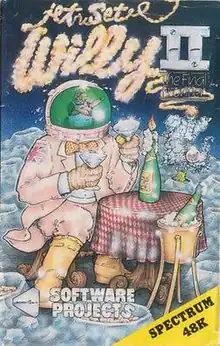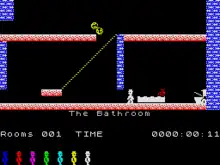Jet Set Willy II
Jet Set Willy II: The Final Frontier is a platform game released 1985 by Software Projects as the Amstrad CPC port of Jet Set Willy.[3] It was then rebranded as the sequel and ported other home computers. Jet Set Willy II was developed by Derrick P. Rowson and Steve Wetherill rather than Jet Set Willy programmer Matthew Smith and is an expansion of the original game, rather than an entirely new one.
| Jet Set Willy II: The Final Frontier | |
|---|---|
 | |
| Developer(s) | Derrick P. Rowson and Steve Wetherill (Amstrad), Derrick P. Rowson (Spectrum), John Darnell and Steve Birtles (C64)[1][2] |
| Publisher(s) | Software Projects |
| Designer(s) | Matthew Smith |
| Series | Miner Willy |
| Platform(s) | ZX Spectrum, Commodore 64, Amstrad CPC, Acorn Electron, BBC Micro, Commodore 16, Amiga, MSX |
| Release | 1985 |
| Genre(s) | Platform |
| Mode(s) | Single-player |
Gameplay

The map is primarily an expanded version of the original mansion from Jet Set Willy, with only a few new elements over its predecessor several of which are based on rumoured events in JSW that were in fact never programmed (such as being able to launch the titular ship in the screen called "The Yacht" and explore an island). In the ZX Spectrum, Amstrad CPC and MSX versions, Willy is blasted from the Rocket Room into space, and for these 33 rooms he dons a spacesuit.
Due to the proliferation of hacking and cheating in the original game, Jet Set Willy II pays homage to this and includes a screen called Cheat that can only be accessed by cheating.[3]
Control of Willy also differs from the original:
- The player can jump in the opposite direction immediately upon landing, without releasing the jump button.
- Willy now takes a step forward before jumping from a standstill.
- Some previous "safe spots" in Jet Set Willy are now hazardous to the player in Jet Set Willy II - the tall candle in "The Chapel" for example.
The ending of the game is also different.
Development

Jet Set Willy II was originally created as the Amstrad conversion of Jet Set Willy by Derrick P. Rowson and Steve Wetherill, but Rowson's use of an algorithm to compress much of the screen data meant there was enough memory available to create new rooms.[1][4]
It came with a form of enhanced copy protection called Padlock II. To discourage felt tip copying,[5] it had seven pages, rather than the single page used in Jet Set Willy.
Software Projects later had Rowson remove all of the enhancements from the Amstrad version to produce a straight conversion of the original ZX Spectrum version of Jet Set Willy. This version was included on the Ocean Software compilation They Sold A Million[6][7][8][2] released in November 1985.[9]
Ports
The game was ported to the ZX Spectrum, Commodore 64, Commodore 16, BBC Micro, Acorn Electron, and MSX.
Rowson ported the game to the Spectrum alone as Steve Wetherill had moved to Odin Computer Graphics.[2] It has a number of small differences, including the loss of coloured backgrounds in certain screens as the CPC version ran in a 4-colour display mode. In an in-depth article about both the game and the code, Your Spectrum stated that as each room was compressed and took up differing amounts of memory, "a room editor would be virtually impossible to write."[10]
The BBC Micro cassette version has 2 rooms not in the ZX Spectrum version, and omits 60 of the rooms, rather than being a subset of it as are the CPC and ZX Spectrum versions.[11]
The C64 screen was a different format to the Amstrad, so the developers were unable to take the data used in the Amstrad and instead had to lay out again and re-implement all the screens and sprites. However, Rowson was able to use much of the data directly from the Amstrad, and hence the game was released sooner.
Reception
The original Amstrad version, released as Jet Set Willy, reached number 2 in the Amstrad games chart for the four weeks up to April 16, 1985.[12] Amstrad Computer User called it "one of the best CPC games around".[3]
Its release as Jet Set Willy II was less well received with Sinclair User's Clare Edgeley calling it the "biggest rip off of them all",[13] while Home Computing Weekly accused Software Projects of "trying to flog it as a new game".[14] Crash said the game was good, but little progress had been made from the original.[1]
The Spectrum and Commodore 64 versions of Jet Set Willy entered the Gallup Top 20 chart in the fortnight up to July 12, 1985, at number 8, rising to number 7 on the following chart.[15][16]
Mastertronic released the game on its Ricochet label in late 1988. While reviewers called the game dated, particularly criticizing the graphics as laughable and "stick-like", they conceded that the gameplay was still "pretty excellent" - the same reviewer who accused the graphics of being "stick-like" also stated that it was "one of [his] all-time favourite games" and "worth a peek".[17][18] The £1.99 release reached number 7 in the ZX Spectrum budget games chart.[17][18][19]
Legacy
Unofficial ports have been written for the Acorn Archimedes, Microsoft Windows, MS-DOS, and the X Window System.[20]
In November 2016 Rowson released JSW2+ as an update. Technical improvements allow for more complicated rooms, and it has built-in cheat devices allowing infinite lives and teleportation. Rowson also added some new rooms, and made many of the rooms easier with fewer or slower sprites.[21]
References
- Carroll, Martyn (March 2004). "Hall of the Miner King". Retro Gamer. No. 1. Imagine. pp. 24–29.
- Carroll, Martyn (3 March 2011). "The Making of Jet Set Willy II". Retro Gamer. No. 87. Imagine. pp. 76–81.
- "Feature: Jet Set Willy". Amstrad Computer User. No. 10. Amsoft. September 1985. pp. 56–61. Retrieved 17 March 2023.
- Rowson, Derek (10 August 2013). "Jet Set Willy II: Comment from Steve Wetherill and Derrick P. Rowson". Retrieved 27 April 2022.
- "Jet Set Willy I & II (Software Projects, 1984 & 1985) – REVIEW | Retrollection.net". Archived from the original on 27 July 2019. Retrieved 27 July 2019.
- "Hitsquad attack at Christmas". Amstrad Action. No. 2. Future Publishing. 10 October 1985. p. 20.
- "Bargain Compilation". Amstrad Computer User. No. 12. Amsoft. November 1985. p. 8.
- "They Sold A Million". Amstrad Action. No. 4. Future Publishing. 12 December 1985. pp. 62–63.
- "They Sold A Million Advertisement". Computer and Video Games. No. 49. EMAP. November 1985. p. 108. Retrieved 18 March 2023.
1st November 1985 Release Date
- Will Meet Again, Your Spectrum issue 18
- "Jet Set Willy II: BBC Micro version". Retrieved 25 October 2010.
- "Gallup Software Chart". Amstrad Computer User. No. 7. Amsoft. June 1985. p. 54. Retrieved 17 March 2023.
- "Software Scene". Sinclair User 1986 Annual. No. 57. EMAP. 5 October 1985. p. 135. Retrieved 17 March 2023.
- "Reviews: Jet Set Willy II". Home Computing Weekly. No. 129. Argus Specialist Publications. 10 September 1985. p. 12. Retrieved 17 March 2023.
- "Top 20 Software Compiled By Gallup". Home Computing Weekly. No. 121. Argus Specialist Publications. 16 July 1985. p. 41. Retrieved 17 March 2023.
- "Top 20 Software Compiled By Gallup". Home Computing Weekly. No. 122. Argus Specialist Publications. 30 July 1985. p. 41. Retrieved 17 March 2023.
- "Jet Set Willy II". Sinclair User. No. 81. EMAP. December 1988. p. 59. Retrieved 17 March 2023.
- "Jet Set Willy: The Final Frontier". Zzap. No. 46. Newsfield. February 1989. p. 92. Retrieved 17 March 2023.
- "Games Chart: Budget Games". Your Sinclair. No. 40. Dennis Publishing. April 1989. p. 9. Retrieved 16 December 2022.
- "The DECWindows Archive - JETSET 1.0". DECWindows and VMS CENA's Archive. Retrieved 23 December 2006.
- Jet Set Willy II: Updated, by Derrick P. Rowson
External links
- Jet Set Willy II at SpectrumComputing.co.uk
- Jet Set Willy II at World Of Spectrum
- Map of the Spectrum version
- Room format description